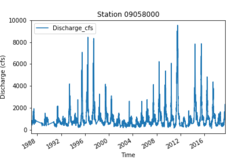Lab-0012: Difference between revisions
No edit summary |
No edit summary |
||
| Line 2: | Line 2: | ||
|Labtitle=River Discharge Data Analysis | |Labtitle=River Discharge Data Analysis | ||
|LabCOModule=1 of 1 | |LabCOModule=1 of 1 | ||
|LabDateContributedOrUpdated=2020/ | |LabDateContributedOrUpdated=2020/08/24 | ||
|LabDescriptionShort=Learn how river stage and discharge are measured | |LabDescriptionShort=Learn how river stage and discharge are measured | ||
Learn how to import and manipulate USGS river discharge data | Learn how to import and manipulate USGS river discharge data | ||
Learn basic principles of csv file import and the Python pandas library | Learn basic principles of csv file import and the Python pandas library | ||
|LabCODuration=3.0 hrs | |LabCODuration=3.0 hrs | ||
|LabModelDocumentation=None | |||
|LabAssociatedLesson=Jupyter Notebook | |LabAssociatedLesson=Jupyter Notebook | ||
|LabURLDownloadNotebook=https:// | |LabURLDownloadNotebook=https://downgit.github.io/#/home?url=https://github.com/csdms/ekt_lab/tree/master/notebooks/discharge_analysis | ||
|LabURLStartNotebook=https://csdms.rc.colorado.edu/hub/user-redirect/git-pull?repo=https%3A%2F%2Fgithub.com%2Fcsdms%2Fekt_lab&urlpath=tree%2Fekt_lab%2Fnotebooks%2Fdischarge_analysis%2FLoadUSGSDischargeData_UpperColorado.ipynb&branch=master | |LabURLStartNotebook=https://csdms.rc.colorado.edu/hub/user-redirect/git-pull?repo=https%3A%2F%2Fgithub.com%2Fcsdms%2Fekt_lab&urlpath=tree%2Fekt_lab%2Fnotebooks%2Fdischarge_analysis%2FLoadUSGSDischargeData_UpperColorado.ipynb&branch=master | ||
}} | }} | ||
{{LabContributorData | {{LabContributorData | ||
|LabContributorName=Irina Overeem | |LabContributorName=Irina Overeem | ||
|LabContributorInstitute=University of Colorado | |LabContributorInstitute=University of Colorado Boulder | ||
}} | }} | ||
{{LabIntro | {{LabIntro | ||
Revision as of 16:02, 24 August 2020
River Discharge Data Analysis
Contributor(s)
- concept of river discharge and stage
- what are stage-discharge relationships
- what are some difficulties for relating stage to discharge
Python Skill Learning Objectives:
- Load csv data from a file using the Pandas library.
- Access data in DataFrames.
- Create plots of data in DataFrames.
- Save figures to file.
Classroom organization
Lab is appropriate for advanced undergraduates and graduate students majoring in earth science/engineering.
We will be looking at data on river discharge - the volume of water transported through a given cross section per time- of the Colorado River. This notebook lends itself well with a short introduction on the concept of river discharge, how it is measured and an introduction on gauging stations of the USGS. The data analysis part requires basic python handling skills, but the coding is introductory level.
Students can run through notebook and are encouraged to do assignments by themselves (or as homework). A review and discussion of solutions by the instructor after completion by the participants is recommended.
You can follow the steps below to test and run the Jupyter Notebooks on the CSDMS JupyterHub server for this lab.
1. Create a free account on the CSDMS JupyterHub at https://csdms.rc.colorado.edu/hub/signup, providing a username and password -- they can be whatever you like
2. Request authorization for your new account through the CSDMS Help Desk at https://github.com/csdms/help-desk/issues/new?assignees=mdpiper&labels=jupyterhub&template=new-csdms-jupyterhub-account.md&title=CSDMS+JupyterHub+account -- if you don't already have a GitHub account, you'll be asked to make one
3. Once approved, run Jupyter Notebooks by clicking on "start" under the "Run online" section (grey table at the top of this lab
page).Download associated file: RiverStageDischargeIntroduction.pdf
Concept Diagrams of Stage and Discharge Measurements
Skills
- Load csv data from a file using the Pandas library
- Access data in DataFrames
- Create plots of data in DataFrames
- Save figures to file
- River discharge and stage
- Stage-discharge relationship
Lab notes
We will be looking at data on river discharge - the volume of water transported through a given cross section per time- of the Upper Colorado River.
River discharge data for many US rivers is available from the USGS water watch website: http://waterwatch.usgs.gov/?m=real&r=co
River stage data is typically measured by keeping track of the water surface height over time, i.e. stage, and this needs to be converted to discharge through a stage-discharge relationship.
Tabular data like this data with a combination of dates, name and data quality strings, and numbers are best handled by spreadsheets where entries such as dates and times are in some useful format. In Python the Python Data Analysis Library (a.k.a. Pandas) is really useful for this purpose.
We use one discharge data file downloaded for the USGS station at Kremmling, CO, for the Upper Colorado.Acknowledgements
CSDMS, NSF Award
References

